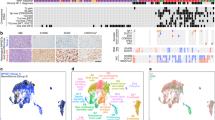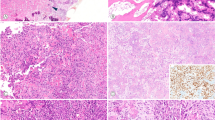Abstract
Neuroblastic tumours are composed of variable proportions of neuroblasts and Schwann cells. Whether both components share a common neoplastic origin is highly debated and discrepant results have been reported about the presence of tumour-related genetic alterations in Schwann cells. We have used X-methylation analysis and array-CGH to investigate contiguous Schwannian and neuroblastic areas in tumours with a nodular pattern. A skewed X inactivation was observed in four out of five stromal components. Interestingly, in these four cases, the X-inactivation profiles of the neuroblastic components were identical to the matched stromal areas. However, whereas all neuroblastic areas displayed chromosomal imbalances, no alteration was found in any Schwann cell components. Similarly, no alteration was observed in a series of 19 tumours with a single stroma-rich component, which occasionally exhibited a skewed X-inactivation pattern (3/17 informative tumours). Altogether, this indicates that most stroma-rich tumours display a polyclonal proliferation and that Schwann cells do not derive from neuroblasts. However, in tumours with both stroma-rich and -poor components, our results suggest that cells from both areas share a common progenitor.
This is a preview of subscription content, access via your institution
Access options
Subscribe to this journal
Receive 50 print issues and online access
$259.00 per year
only $5.18 per issue
Buy this article
- Purchase on Springer Link
- Instant access to full article PDF
Prices may be subject to local taxes which are calculated during checkout





Similar content being viewed by others
References
Ambros IM, Attarbaschi A, Rumpler S, Luegmayr A, Turkof E, Gadner H et al. (2001). Neuroblastoma cells provoke Schwann cell proliferation in vitro. Med Pediatr Oncol 36: 163–168.
Ambros IM, Zellner A, Roald B, Amann G, Ladenstein R, Printz D et al. (1996). Role of ploidy, chromosome 1p, and Schwann cells in the maturation of neuroblastoma. N Engl J Med 334: 1505–1511.
Bhattacharyya I, Williamson A, Cohen DM, Bever JL . (1999). Metastatic neuroblastoma with ganglioneuromatous differentiation and mandibular involvement. Oral Surg Oral Med Oral Pathol Oral Radiol Endod 88: 586–592.
Chen GL, Prchal JT . (2007). X-linked clonality testing: interpretation and limitations. Blood 110: 1411–1419.
Coco S, Defferrari R, Scaruffi P, Cavazzana A, Di Cristofano C, Longo L et al. (2005). Genome analysis and gene expression profiling of neuroblastoma and ganglioneuroblastoma reveal differences between neuroblastic and Schwannian stromal cells. J Pathol 207: 346–357.
Dupin E, Baroffio A, Dulac C, Cameron-Curry P, Le Douarin NM . (1990). Schwann-cell differentiation in clonal cultures of the neural crest, as evidenced by the anti-Schwann cell myelin protein monoclonal antibody. Proc Natl Acad Sci 87: 1119–1123.
Haas D, Hablin AR, Miller C, Zoger S, Matthay KK . (1988). Complete pathologic maturation and regression of stage IVS neuroblastoma without treatment. Cancer 62: 815–825.
Idbaih A, Marie Y, Pierron G, Brennetot C, Hoang-Xuan K, Kujas M et al. (2005). Two types of chromosome 1p losses with opposite significance in gliomas. Ann Neurol 58: 483–487.
Jovanovic L, Delahunt B, McIver B, Eberhardt NL, Grebe SK . (2003). Thyroid gland clonality revisited: the embryonal patch size of the normal human thyroid gland is very large, suggesting X-chromosome inactivation tumour clonality studies of thyroid tumours have to be interpreted with caution. J Clin Endocrinol Metab 88: 3284–3291.
Kubota T, Nonoyama S, Tonoki H, Masuno M, Imaizumi K, Kojima M et al. (1999). A new assay for the analysis of X-chromosome inactivation based on methylation-specific PCR. Hum Genet 104: 49–55.
La Rosa P, Viara E, Huppe P, Pierron G, Liva S, Neuval P et al. (2006). VAMP: visualization and analysis of array-CGH, transcriptome and other molecular profiles. Bioinformatics 22: 2066–2073.
Liu S, Tian Y, Chlenski A, Yang Q, Zage P, Salwen HR et al. (2005). Cross-talk between Schwann cells and neuroblasts influences the biology of neuroblastoma xenografts. Am J Pathol 166: 891–900.
Merlo GR, Cropps CS, Callhan R, Takahashi T . (1991). Detection of loss of heterozygosity in tumour DNA samples by PCR. Biotechniques 11: 166–168, 170–171.
Mora J, Cheung NK, Juan G, Illei P, Cheung I, Akram M et al. (2001). Neuroblastic and Schwannian stromal cells of neuroblastoma are derived from a tumoral progenitor cell. Cancer Res 61: 6892–6898.
Nishihira H, Toyoda Y, Tanaka Y, Ijiri R, Aida N, Takeuchi M et al. (2000). Natural course of neuroblastoma detected by mass screening: a 5-year prospective study at a single institution. J Clin Oncol 18: 3012–3017.
Novelli M, Cossu A, Oukrif D, Quaglia A, Lakhani S, Poulsom R et al. (2003). X-inactivation patch size in human female tissue confounds the assessment of tumour clonality. Proc Natl Acad Sci USA 100: 3311–3314.
Peuchmaur M, d'Amore ES, Joshi VV, Hata J, Roald B, Dehner LP et al. (2003). Revision of the International Neuroblastoma Pathology Classification: confirmation of favorable and unfavorable prognostic subsets in ganglioneuroblastoma, nodular. Cancer 98: 2274–2281.
Rangecroft L, Lauder I, Waqqet J . (1978). Spontaneous maturation of stage IV-S neuroblastoma. Arch Dis Child 53: 815–817.
Raskind WH, Steinman L, Najfeld V . (1998). Clonal development of myeloproliferative disorders: clues to hematopoietic differentiation and multistep pathogenesis of cancer. Leukemia 12: 108–116.
Sugimoto T, Kato T, Sawada T, Horii Y, Kemshead JT, Hino T et al. (1988). Schwannian cell differentiation of human neuroblastoma cell lines in vitro induced by bromodeoxyuridine. Cancer Res 48: 2531–2537.
Tsai YC, Lu Y, Nichols PW, Zlotnikov G, Jones PA, Smith HS . (1996). Contiguous patches of normal human mammary epithelium derived from a single stem cell: implications for breast carcinogenesis. Cancer Res 56: 402–404.
Acknowledgements
We thank Loic de Pontual for his help in the analysis of the X-methylation pattern. This work was supported by grants from the Ligue Nationale Contre le Cancer (Equipe Labellisée), INSERM and Institut Curie. Franck Bourdeaut is a recipient of fellowships from the Fondation pour la Recherche Medicale and the Association pour la Recherche contre le Cancer.
Author information
Authors and Affiliations
Corresponding author
Additional information
Supplementary Information accompanies the paper on the Oncogene website (http://www.nature.com/onc).
Rights and permissions
About this article
Cite this article
Bourdeaut, F., Ribeiro, A., Paris, R. et al. In neuroblastic tumours, Schwann cells do not harbour the genetic alterations of neuroblasts but may nevertheless share the same clonal origin. Oncogene 27, 3066–3071 (2008). https://doi.org/10.1038/sj.onc.1210965
Received:
Revised:
Accepted:
Published:
Issue Date:
DOI: https://doi.org/10.1038/sj.onc.1210965
Keywords
This article is cited by
-
Tissue-resident glial cells associate with tumoral vasculature and promote cancer progression
Angiogenesis (2023)
-
Precise identification of cancer cells from allelic imbalances in single cell transcriptomes
Communications Biology (2022)
-
Impact of extracellular matrix stiffness on genomic heterogeneity in MYCN-amplified neuroblastoma cell line
Journal of Experimental & Clinical Cancer Research (2020)
-
11q deletion in neuroblastoma: a review of biological and clinical implications
Molecular Cancer (2017)
-
Schwann cells: a new player in the tumor microenvironment
Cancer Immunology, Immunotherapy (2017)



